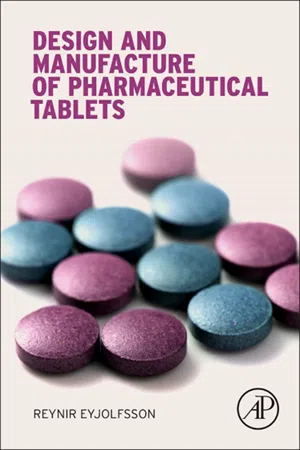
- 68 pages
- English
- ePUB (mobile friendly)
- Available on iOS & Android
Design and Manufacture of Pharmaceutical Tablets
About this book
Design and Manufacture of Pharmaceutical Tablets offers real world solutions and outcomes of formulation and processing challenges of pharmaceutical tablets. This book includes numerous practical examples related to actual formulations that have been validated and marketed and covers important data in the areas of stability, dissolution, bioavailibity and processing. It provides important background and theoretical information on design and manufacturing and includes a full section dedicated to design experimental methodology and statistics. In addition, this book offers a a general discussion of excipients used in proper tablet design along with practical examples related to excipients. Drug development scientists in industry and academia, as well as students in the pharmaceutical sciences will greatly benefit from the practical knowledge and case examples provided throughout this book.- Incorporates important mathematical models and computational applications- Includes unique content on central composite design and augmented simplex lattice- Provides background on important design principles with emphasis on quality-based design (QBD) of pharmaceutical dosage forms
Frequently asked questions
- Essential is ideal for learners and professionals who enjoy exploring a wide range of subjects. Access the Essential Library with 800,000+ trusted titles and best-sellers across business, personal growth, and the humanities. Includes unlimited reading time and Standard Read Aloud voice.
- Complete: Perfect for advanced learners and researchers needing full, unrestricted access. Unlock 1.4M+ books across hundreds of subjects, including academic and specialized titles. The Complete Plan also includes advanced features like Premium Read Aloud and Research Assistant.
Please note we cannot support devices running on iOS 13 and Android 7 or earlier. Learn more about using the app.
Information
Introduction
Abstract
Keywords
1.1. General considerations [1, 2]
Table of contents
- Cover
- Title page
- Table of Contents
- Copyright Page
- Dedication
- Preface
- Abbreviations
- Chapter One: Introduction
- Chapter Two: Conventional-Release (CR) Tablets
- Chapter Three: Slow-Release (SR) Tablets
- Index